One of the more reassuring things about cannabinoids is that if you decide to stop using them, the withdrawal symptoms are generally not as intense or life-threatening as those experienced when quitting substances like alcohol or opioids.
In the case of alcohol or opioid addiction, stopping suddenly can sometimes trigger serious—even dangerous—withdrawal effects. Fortunately, with cannabinoids, the symptoms tend to be milder, though they can still be uncomfortable and challenging to deal with.
In this article, we’ll explore:
-
What withdrawal symptoms you might experience after quitting cannabinoids
-
How long these symptoms typically last
-
And most importantly, how to manage them effectively and get through the process smoothly
Why Withdrawal Happens, After Quitting?
If you suddenly stop smoking weed, you start getting very problematic symptoms, which we call withdrawal effects.
Why does withdrawal occur in the body?
Because suddenly the body stops getting the cannabinoids that provide energy and the body is unable to adjust itself to it.
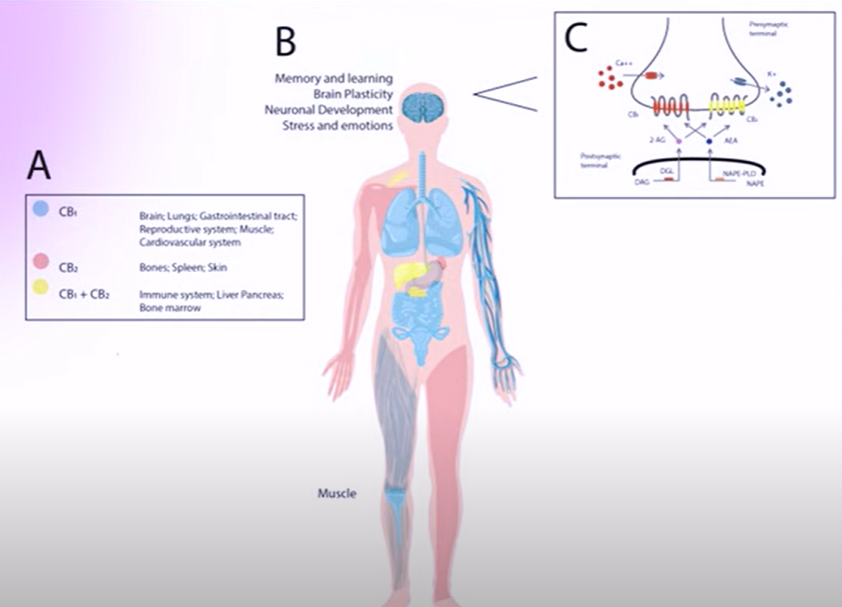
Our body naturally has an endocannabinoid system—a network of receptors and chemicals that helps regulate mood, sleep, appetite, and more. It produces its own cannabinoids and has specific receptors designed to respond to them.
However, when you regularly use external cannabinoid substances (like cannabis), your body starts to adjust:
-
It reduces its own production of endocannabinoids
-
Lowers the number of cannabinoid receptors
-
And decreases receptor sensitivity
Why? Because it’s already getting a steady supply of cannabinoids from outside sources, so the body doesn’t feel the need to produce or maintain its own system at full capacity.
Now, when you suddenly stop using cannabinoids, your body doesn’t immediately bounce back. It needs time to reactivate its internal system, start producing natural endocannabinoids again, and restore receptor function.
During this adjustment period, you may experience withdrawal symptoms. These effects are temporary, and they will ease off as your body slowly regains balance.
So if you’re feeling uncomfortable after quitting, remind yourself:
These symptoms won’t last forever—your body is healing.
What Happens When You Quit Cannabinoids?
Let’s now take a look at:
-
How long withdrawal symptoms might last
-
What symptoms to expect
-
And when you can expect to feel better
Withdrawal symptoms can vary from mild to quite bothersome, depending on several factors:
-
How heavily and how long you’ve been using cannabinoids
-
Gender – studies suggest women may experience more intense symptoms
-
A history of psychiatric disorders (either personal or in the family) can also increase the severity
Cannabinoids vs. Multiple Substance Use: What to Expect During Withdrawal
One important thing to understand is the difference between quitting just cannabinoids versus quitting multiple substances at once.
If you’ve been using multiple substances—like smoking cigarettes, consuming alcohol, or using opioids—and you stop everything suddenly, the withdrawal symptoms can be much more intense and difficult to manage.
On the other hand, if you’ve only been using cannabinoids and decide to quit, the symptoms are usually milder and more manageable. While you may still feel some discomfort, it’s generally something you can cope with without serious complications.
1st Day of Quitting Weed
You will feel almost no symptoms in the first 24 hours, because the level of cannabinoids or THC remains maintained in your blood.
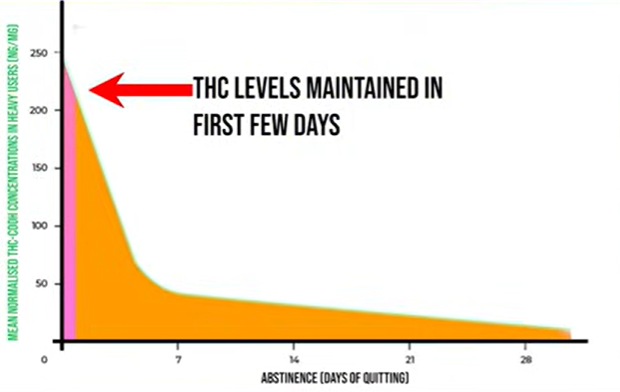
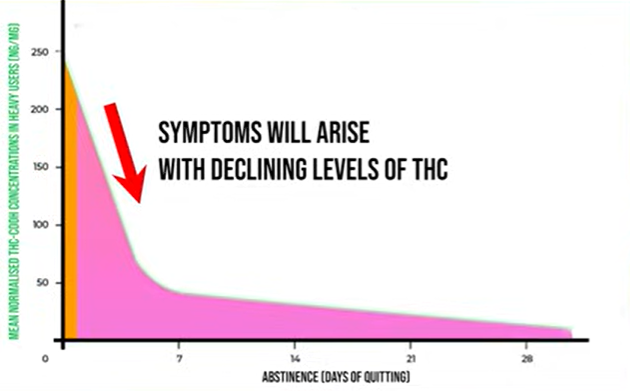
Symptoms will start to be felt when the level of THC starts dropping. THC level remains the same.
Here’s a rephrased version of your content in a clear and engaging tone:
What Happens on Day 2 After Quitting Cannabinoids?
Around 48 hours after you stop using cannabinoids, your THC levels in the blood begin to drop noticeably, and that’s when the first withdrawal symptoms usually start to appear—most of which are physical.


Here are the common early signs you might experience:
Physical Symptoms (Day 2 Onward):
-
Reduced THC levels in the bloodstream
-
Difficulty sleeping or insomnia
-
Loss of appetite
-
Chills or shakiness
-
Headaches
These symptoms are your body’s initial reaction to the sudden absence of THC. While they can be uncomfortable, they are generally manageable and tend to improve with time.
Days 4–6: The Toughest Phase
By Day 4, the physical symptoms that began around Day 2—like sleeplessness, loss of appetite, chills, trembling, and sweating—are usually at their peak. You may also start experiencing mild fever or stomach discomfort.
It can feel overwhelming, but remind yourself:
This is temporary. Your body is healing.
Think of it like being unwell—it’s uncomfortable, but it passes. During this time:
-
Stay clean and avoid smoking at all costs
-
Keep reminding yourself that symptoms at their peak are a sign that they’ll soon begin to decline
-
Psychological symptoms like anxiety, irritability, and restlessness also begin to emerge during this phase
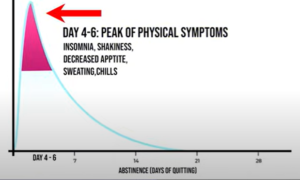
Common Symptoms (Days 4–6):
-
Insomnia
-
Low appetite
-
Shaking or chills
-
Fever
-
Sweating
-
Irritability
-
Anxiety
-
Restlessness
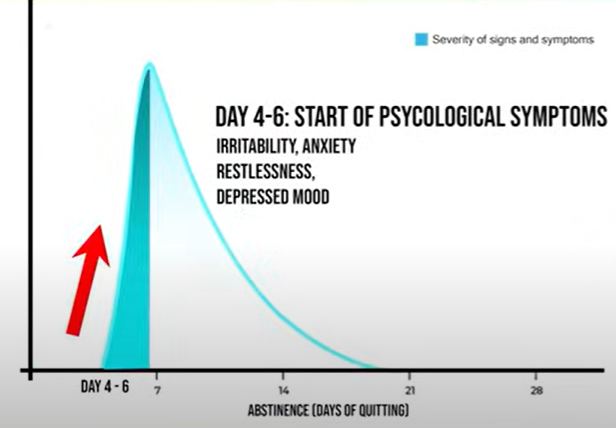
Day 7: A Turning Point
By the end of the first week, some of the initial issues—like trouble sleeping and low appetite—start to ease. Your body begins to restore its own endocannabinoid system, and things slowly start improving.
However, this is also when psychological symptoms peak, especially:
-
Irritability
-
Mood swings
-
Anxiety
-
Mental restlessness
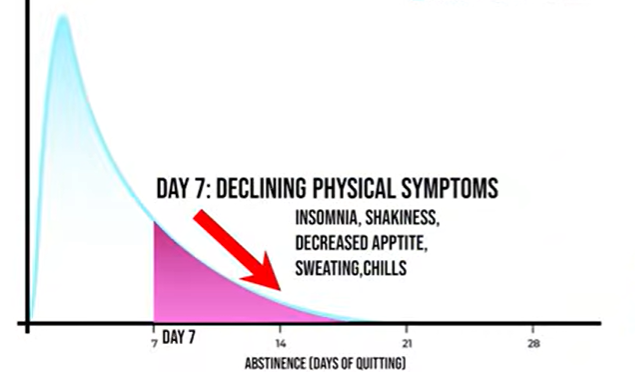
To manage this phase:
-
Stay active with light exercise
-
Stay hydrated
-
Talk to supportive friends or family
-
Try relaxing activities like a walk, deep breathing, or gentle yoga
Exercise and hydration are two of your biggest allies in managing withdrawal symptoms.
Day 10: Physical Relief, Mental Shifts
By Day 10 your body will have crossed a very tough phase and many of the symptoms will start settling down.
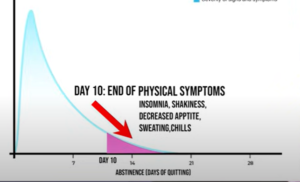
The physical symptoms which you had in the beginning will almost have gone away. The psychological symptoms like anxiety, restlessness and irritability will also start settling down around Day 10.

Around Day 10 your body also starts producing its own endocannabinoid substance and many things will settle down.
After Day 10 two new symptoms start appearing which will trouble you for the next 10 to 12 days.
- Strange dreams
- Anger or Aggression
Strange Dreams
You may get strange, drawn dreams for the next 10 to 12 days. You have to understand that these dirty dreams will come, they are a part of your withdrawal.
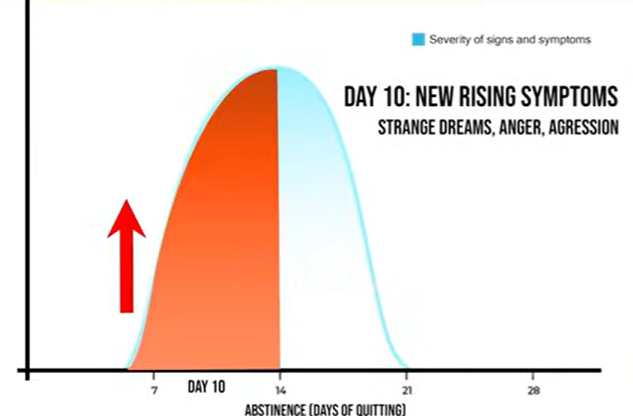
It is just temporary and with this one information you will deal with them easily.
The second symptom which will start troubling you is,
Anger Or Aggression
Anger or aggression will last for 10 to 12 days. This is just a part of withdrawal from education, so being angry will help you deal with this anger and keep your mind calm.
- Physical & psychological symptoms become reduces.
- Strange dreams & Anger or aggression occurs
2 Weeks of Quitting Weed
Within 2 weeks or 14 days almost all the symptoms will have gone. You start feeling much better.
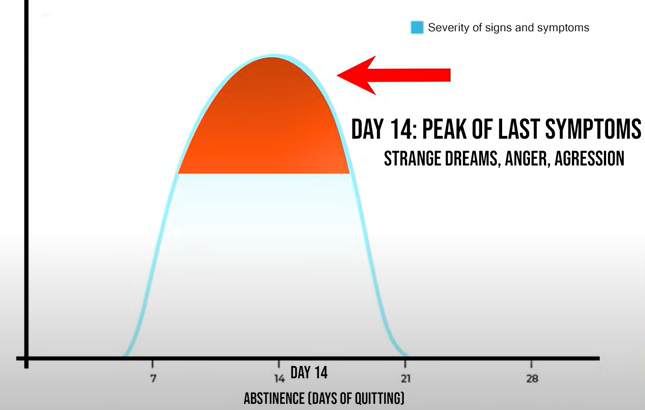
By the end of the second week, you’ll notice a significant improvement. Most symptoms will have eased off.
However, dreams and irritability may still linger, especially if they peaked around Day 10. It’s important to remind yourself that:
-
These symptoms are still part of the healing process
-
They will pass
-
You’re almost through the hardest part
Week 3: Back to Balance
Around the 3rd week all your symptoms go away and you are completely back to normal consciousness.
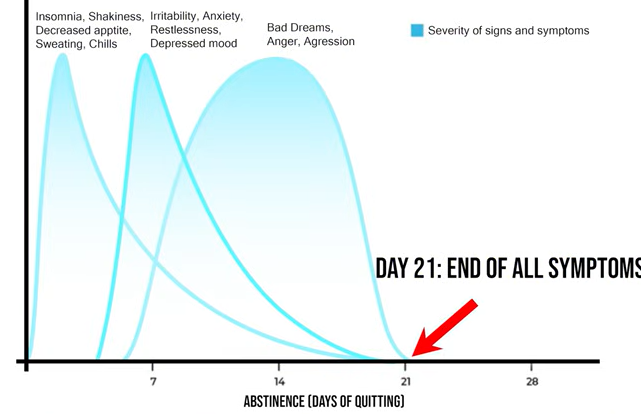
By the third week, the majority of symptoms—physical and emotional—will have disappeared. You’ll likely feel back to your normal self, with improved clarity, focus, and mood.
In some cases, vivid dreams may persist a little longer. This is due to a process called neuroplasticity—your brain is rewiring itself after long-term exposure to cannabinoids. It just needs a bit more time to fully stabilize.
Summary of Key Withdrawal Phases
-
Days 2–6: Physical symptoms peak (sleeplessness, chills, headaches)
-
Days 4–10: Psychological symptoms rise (irritability, anxiety, restlessness)
-
Days 10–14: Strange dreams & aggression may occur
-
Week 3: Most symptoms fade, lingering dreams may persist due to brain adjustments
How to Deal With Withdrawal: Tips That Work
The most important thing to remember is this:
Withdrawal symptoms are temporary—and a sign your body is healing.
Here’s how to support yourself through the process:
1. Exercise Regularly
Even light aerobic activity boosts your mood, improves sleep, and speeds up recovery.
2. Stay Hydrated
Drink plenty of water to flush out toxins and keep your energy up.
3. Stay Connected
Talk to friends, family, or someone you trust. Having support helps reduce the urge to relapse.
4. Ask for Help When Needed
If you’re struggling, reach out for guidance or counseling—even a short talk can help you reset.
5. Use Relaxation Techniques
Try yoga, meditation, listening to calming music, or spending time in nature. Visiting peaceful places like beaches or mountains can also help ease your mind.
Final Thought
Quitting weed is a process—but one that’s absolutely doable. By understanding what to expect, staying mentally prepared, and taking care of your body, you can come out of this stronger, healthier, and in full control again.
You’ve got this.